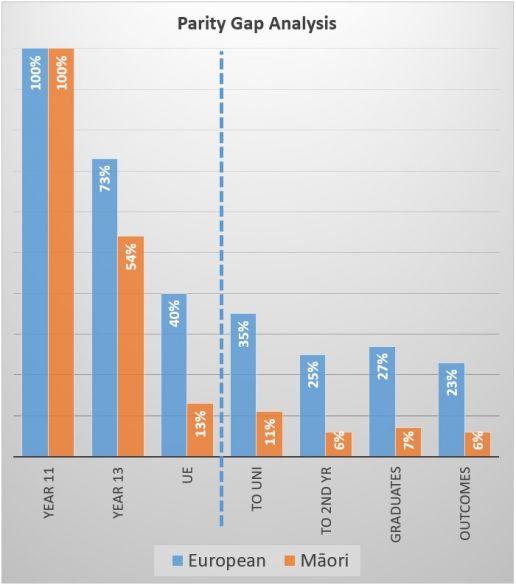What would it take to achieve parity?
29 January 2019 | news
“We need a whole-of-sector approach to this,” says Dr Darryn Russell, Chair of Universities New Zealand’s Te Kāhui Amokura, talking about the need for action on lifting Māori and Pasifika participation and achievement rates in tertiary education.
“And we as a sector have to provide a more human response to the needs of the student.”

Universities New Zealand is looking at what it would take to achieve parity of outcomes for Māori and Pasifika students in both the compulsory education sector and at university. The work has been contributed to by Te Kāhui Amokura, Komiti Pasifika, the Deputy Vice-Chancellors (Academic), planning directors and the steering group of AQA’s Cycle 6 Enhancement Theme.
Universities analysed the academic performance of Māori, Pasifika and European/Pākeha students and found that non-academic factors accounted for 10%, at most, of the difference in the percentage of students who successfully completed university studies.
Far more important was academic preparedness, where NCEA results correlated strongly with academic success at university. A student with a bare pass in NCEA was more likely to struggle academically at university than a student with merit or excellence passes in their NCEA subjects.
The analysis found that Māori and Pasifika students were coming into the university system with a lower proportion of merit or excellence passes than, say, European/ Pākeha students. For example, twice as many Māori students (12% versus 6%) had NCEA results that were near the minimum entry requirements to university. Similarly, 22% of Māori students had very strong NCEA results (excellence in most or all NCEA subjects) compared with 35% for European/Pākeha students.
The conclusion was that a disproportionate number of Maori and Pasifika were still struggling at university because they were leaving school with comparatively poor NCEA results—compared with, say, European/Pākeha students.

Support in schooling system vital
Analysis in an August UNZ discussion paper indicated that the best way to achieve genuine outcomes for Māori and Pasifika was to ensure all students were supported to achieve their potential back in the schooling system. The analysis suggested that schools could not do this by themselves, but it was possible if Government and universities worked with schools, their students and their families and communities. All parts of the system need to collaborate and be well-coordinated to achieve parity of outcomes for Māori and Pasifika students.
“We’ve done good work in pockets in the sector to address the disparity of Māori in the institutions. But nationally and institutionally we’re failing,” says Dr Russell.
The August paper made nine recommendations, while a second, recently completed paper looks at how these recommendations could be implemented, taking an investment approach. Both private and public benefits are calculated—economic and social—looking at what would be possible if parity was achieved and another 3800 Māori and 1707 Pasifika students were getting degrees each year.
Recommendations
The paper proposes five overlapping and mutually reinforcing clusters of initiatives to implement the recommendations.
The first cluster is vital as it involves getting the foundations in place for successfully lifting participation and achievement. It reinforces Dr Russell’s point that a whole-of-sector approach is vital and says that parity can be achieved only if there is a sustained middle-to-long-term, whole-of-Government approach that harnesses the entire school and tertiary system effectively. One Government strategy, one set of goals and a single, high-level role within the Ministry of education with overall responsibility for driving successful delivery are proposed.
Performance measures that are more robust and sophisticated than the current Education Performance indicators are also needed, at both secondary and tertiary levels, looking at the performance of cohorts over time and against other comparable providers. This should be accompanied by systems, processes and good practice guidance to support schools.
“Parity in the universities is improving—but parity to get to university is unequal,” says Dr Russell. “We can’t reach back into the compulsory sector, but we need that performance lifted to improve our performance.”
The second cluster of recommendations focuses on extending proven interventions for Māori and Pasifika at university and lifting completion rates. Over 300 initiatives aimed at lifting participation and achievement across seven of New Zealand’s eight universities have been identified, including bridging and foundation programmes, commuting or travel grants and other initiatives using current equity funding. The paper recommends that this funding should be maintained—and increased, if the Government wants to encourage more such activity.
Increasing programmes to familiarise school students with the university environment, improving funding and support for foundation programmes—and removing them from being counted in a student’s fees-free eligibility—and increasing pastoral support for struggling students are all proposed and costed as part of this cluster.
Cluster three proposes using analytics-informed support for school students and sharing good practice in curriculum design and delivery. The paper recommends that the TEC’s work in generating tools and setting standards for delivering pathways advice and planning in schools should be extended beyond careers advice to deliver tools for pathways that would enable schools to track students and see whether they were on track or at risk of going off-track.
Universities, schools working together
Universities working with schools to deliver curriculum, particularly in STEM subjects, is key to Cluster four recommendations. Measures to support schools could include universities delivering curriculum into secondary schools—such as Massey University’s Pūhoro STEM Academy—sending school students to universities with specialist equipment and teachers or resourcing regional hubs with equipment and expertise where no university is within a reasonable distance.
A national network of university and regional teaching hubs would require a significant investment but would deliver the curriculum more efficiently and effectively than is possible across hundred of schools where access to qualified teacher and teaching facilities is a challenge.
Cluster five focuses on measures to grow and support the pool of teachers with STEM, Te Reo and other specialist subjects where teachers are hard to find and keep. Raising incentives to attract qualified teaching staff to difficult-to-fill positions will be important; STEM-qualified graduates can earn a lot more outside the teaching profession, and this must be addressed before issues of recruitment and retention can be addressed. Options to remedy this could include employment guarantees, write-downs on student loan balances and other incentives.
The paper outline three possible implementation approaches, with broad cost estimates, ranging from a minimum meaningful approach to a comprehensive and ambitious one.
“What has driven this work is that we have disparity out there,” says Dr Russell. “It should be of concern to Government as well as to…the wider community. The big concern I have is that if we don’t fix it, we have inequity in our society.
“We have got better in the past three decades, but the Cycle 6 enhancement theme tells us we’re not there yet.
“Through all this, we need to keep in mind the students. I know how important data is, but it’s the human element and organisational culture that need to underpin the change necessary to achieve parity. That’s a whole lot harder, but has to be a key ingredient for change.”
“This paper provides a response that—if successful—is great for students, institutions and the country.”
